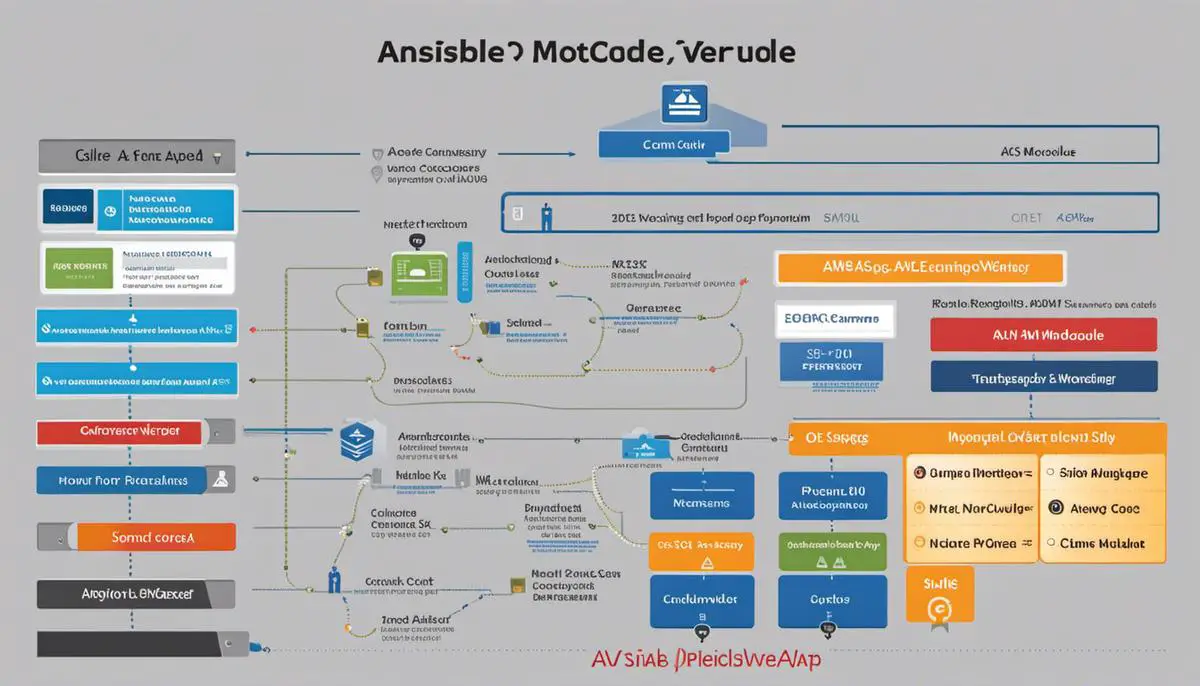In the evolving world of software development, the use of automated tools for management and deployment is becoming more essential. Ansible, a leading open-source software provisioning, configuration management, and application-deployment tool, has gained tremendous popularity in this sector. Coupled with Ubuntu’s Advanced Packaging Tool (APT) and specifically the APT-Get command-line tool, programmers can achieve seamless supervision of packages and system updates. This consideration sets out to demystify Ansible and APT-Get individually, and then dive into Ansible’s apt module, exploring how it effectively manages packages on Debian-based systems. We will culminate by examining practical applications, thereby consolidating the theory into useful, hands-on skills.
Understanding Ansible
Understanding Ansible and Its Uses
Ansible is an open-source automation tool for managing configurations and deploying applications, widely used in software provisioning. You might say that Ansible is like a Swiss army knife for IT professionals, able to handle different tasks with a single tool. Ansible uses a simple syntax written in YAML, which you can use to describe automation jobs in a way that approaches plain English. This makes it an excellent tool for teams looking for efficient ways to manage their system infrastructure.
The Architecture of Ansible
Ansible follows a simple master-minion setup, with the master machine controlling the minions. It pushes modules to the minions and these modules are stored temporarily on the remote nodes and communicated via JSON over standard output. One important aspect to remember is that Ansible is agent-less, meaning you don’t have to install any other software or firewall ports on the client systems you wish to automate. You also don’t have to set up a separate management structure.
Setting Up Ansible
Installing Ansible is straightforward. On Debian or Ubuntu systems you can use apt-get, which is the package handling utility. You would use the following command to install Ansible:
sudo apt-get update
sudo apt-get install software-properties-common
sudo apt-add-repository --yes --update ppa:ansible/ansible
sudo apt-get install ansible
For other systems, you may use your default package manager (like yum for CentOS).
Configuring Ansible
Once you have Ansible installed, you’ll want to create a configuration file. This file is typically located at /etc/ansible/ansible.cfg. If you installed from a package, this file should already exist but you can create it if necessary. In this file, you can set parameters like the remote user, privilege escalation settings, and more.
You will also need to create an inventory file, normally located at /etc/ansible/hosts. Here you should put all the hosts that you would like to manage with ansible.
Using Ansible
To use Ansible, you mainly work with playbooks. These are Ansible’s configuration, deployment, and orchestration language. You can describe a policy you want your remote systems to enforce or a set of steps in a general IT process.
In the basics of Ansible, you’ve learned what it is and its architecture. You have also seen how to install and configure Ansible. However, Ansible’s real power comes from its playbooks where its simplicity and power really shine.

Introduction to APT-Get
APT-Get: An Overview
APT-Get, or Advanced Packaging Tool-Get, is a user-friendly command-line tool utilized for managing Ubuntu’s software packages. Through APT-Get, a user has the ability to install, remove, update, and manage software on a Unix-like system, including Debian, Ubuntu, or any of their derivatives.
Using APT-Get to Install Software Packages
APT-Get shines in its convenience to quickly install software packages. To install a specific software package, you would simply enter “sudo apt-get install [name of the package]”. Here, ‘sudo’ gives you administrative permissions, ‘apt-get’ signals the tool you’re using, ‘install’ is the command you’re issuing to apt-get, and ‘[name of the package]’ is, obviously, the name of the software package you’re looking to install.
Removing and Upgrading Software with APT-Get
APT-Get also simplifies the processes for removing and upgrading software. To remove a software package, you would enter “sudo apt-get remove [name of the package]”, and to upgrade, you would submit “sudo apt-get upgrade”. The command “sudo apt-get upgrade” upgrades all the installed packages on your Ubuntu system.
APT-Get and System Updates
For overall system updates, the command “sudo apt-get update” can be used to synchronize your system with the online software repositories. This ensures your system has information on the most current state of packages and their respective versions. It is useful to get updates before installing new software to ensure you are getting the latest version.
Handling Package Dependencies with APT-Get
One of the primary advantages of APT-Get is its handling of package dependencies. Apt-Get automatically looks for and installs any other packages necessary for the software you’re installing to work properly. This feature simplifies the installation process and helps to prevent software conflicts.
In conclusion, the APT-Get tool is a powerful resource for managing software packages on Unix-like systems. It simplifies installation, removal, and upgrades of software packages, and automatically handles package dependencies, all through a few simple command line entries.

Working with Ansible Apt Module
Ansible Apt Module Overview
The Ansible apt module is an essential tool for managing packages on Debian-based Linux distributions, like Ubuntu. This module helps to automate software management processes by allowing you to install, upgrade, or remove packages on your system with ease.
Installing Packages using Ansible Apt Module
To install a package using the Ansible apt module, you will need to specify the name of the package and state that you want it installed. Here is an example:
- name: Install git
apt:
name: git
state: present
In this example, the “name” parameter refers the package you want to install, in this case “git”. The “state” parameter is set to “present” to indicate that you want the package installed.
Updating Packages using Ansible Apt Module
To update a package using the Ansible apt module, you can again use the “name” and “state” parameters, but this time set the state to “latest”. This will ensure the package is updated to its latest version. Here is an example:
- name: Update git
apt:
name: git
state: latest
Removing Packages using Ansible Apt Module
Just like installing and updating, you can also remove packages using the Ansible apt module by setting the “state” parameter to “absent”. This will remove the package from your system. Here is an example:
- name: Remove git
apt:
name: git
state: absent
Updating the System
The Ansible apt module also allows you to update all packages on your system, similar to running ‘apt-get update && apt-get upgrade’. This is achieved with the “upgrade” parameter, which should be set to “dist”. Here’s a simple playbook example:
- name: Update All Packages
apt:
upgrade: dist
Ansible Apt Module’s Auto-Remove Function
To remove packages that were automatically installed to satisfy dependencies for some package and no longer needed, you can use the “autoremove” option and set it to “yes. Here’s an example:
- name: Auto remove packages
apt:
autoremove: yes
To summarize, the Ansible apt module is an extremely useful tool for managing packages on Debian-based Linux distributions. Through a series of simple commands and parameters, you can easily automate the process of adding, updating, and removing software on your system.

Practical Applications of Ansible Apt-Get
Understanding Ansible Apt-Get
Ansible is an IT automation tool that can configure systems, deploy software, and perform more complex IT tasks such as continuous deployments or zero downtime rolling updates. One of Ansible’s many modules is the apt module. It is a package management module for Debian-based systems, and it is used much like the apt-get command would be on any Debian-based Linux system.
Installing a Package Using Ansible Apt-Get
If you want to install a software package on one or more machines, it’s possible to achieve this using Ansible apt-get. Here is a sample Ansible playbook which installs nginx on your targeted hosts.
---
- hosts: your-server
tasks:
- name: Install nginx
apt:
name: nginx
state: present
In this case, ‘your-server’ is the alias for the destination server present in your Ansible inventory file. ‘nginx’ is the package we want to install and ‘present’ ensures that it’s installed.
Running the playbook would install nginx on your machine.
Updating Repository Cache And Installing Package
Sometimes, it is necessary to update the local package cache before attempting installation. Here is how you could structure this using Ansible:
---
- hosts: your-server
tasks:
- name: Update system
apt:
update_cache: yes
- name: Install nginx
apt:
name: nginx
state: present
‘update_cache: yes’ is used to update the local package cache.
Managing Package Versions
Ansible apt module also allows you to handle specific package versions. For example, if you want to install a particular version of nginx:
---
- hosts: your-server
tasks:
- name: Install specific version of nginx.
apt:
name: nginx=1.14.0-0ubuntu1
state: present
‘nginx=1.14.0-0ubuntu1’ specifies the version of nginx to be installed.
In conclusion, Ansible apt-get enables efficient and standardized deployment through the use of simple and reusable scripts. With these scripts, system administration tasks are easier, faster, and more reliable.

The ability to automate and manage tasks effectively is a cornerstone of productive software development. The apt module in Ansible, working conjointly with APT-Get, achieves just that by streamlining package management and system updates. The practical application of this powerful duet of tools affords users the means to efficiently deploy standardized systems across multiple machines. By consolidating theory with practice, the understanding and use of these tools become essential facets of the software developer’s toolkit. Thus, enhancing proficiency, productivity, and ultimately helping to build robust, high-performance systems.